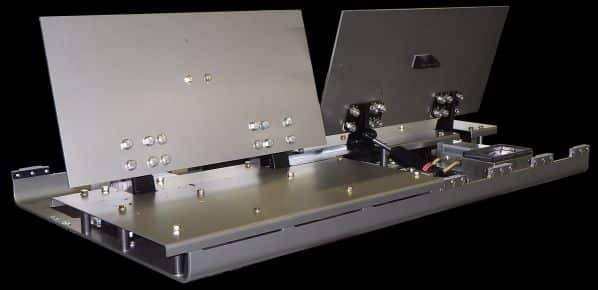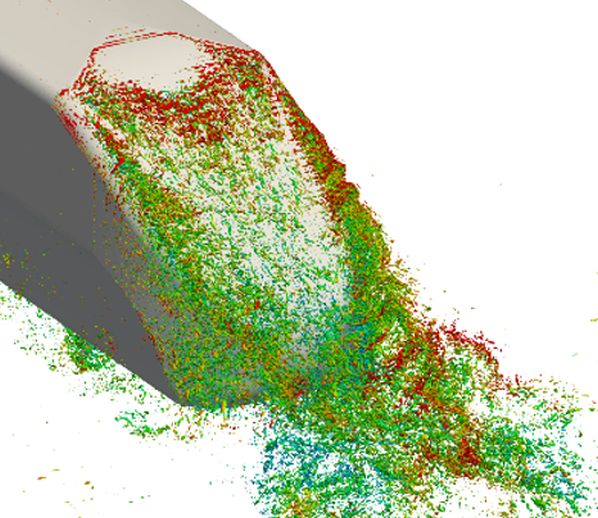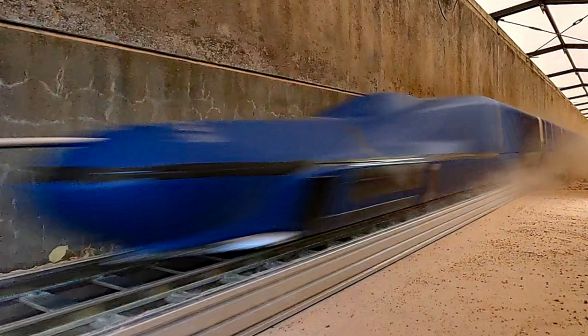AERODYNAMIC phenomena are important factors that directly affect the stability and ride comfort of rolling stock operating on the railway. These can include strong winds overturning trains, air resistance, vehicle vibration caused by fluctuating aerodynamic force, fluctuation in pantograph lift force, and the build-up of snow on bogies.
At the lineside, aerodynamic phenomena include pressure fluctuation, drafts caused by passing trains and air currents causing ballast to be dislodged. The noise and pressure waves generated in tunnels which affect the lineside environment are also caused by aerodynamic phenomena.
As a function of train speed, these phenomena are more significant in high-speed operations, and as the world’s high-speed network grows it becomes ever more important to resolve the issues they cause. Japan’s Railway Technical Research Institute (RTRI) is performing research to predict and investigate these phenomena and to develop methods to mitigate them, using numerical simulations, experiments using models and field tests.
When a train’s speed increases, air resistance rapidly increases, and this is the dominant factor causing running resistance. It is therefore necessary to limit air resistance in order to reduce energy consumption. As high-speed trains such as the Shinkansen in Japan are long and have streamlined noses and rear ends, air resistance of the intermediate vehicles is now the most important factor. Smoothing every part of the intermediate vehicles is one way to effectively reduce air resistance, and recent builds of Shinkansen feature coverings for bogie sides, couplings and other parts of the train to reduce air resistance and noise.
At RTRI, we recently conducted wind tunnel tests to evaluate the impact on air resistance of the recesses around train windows and sliding passenger doors. The results showed that the air resistance of a sliding door was approximately 20 times greater than that of a window. Moreover, the results also indicated that the air resistance of an intermediate vehicle with four sliding doors and 40 windows could be reduced by about 2.6% by smoothing all the recesses.
But high-speed trains can also make use of air resistance, and RTRI has developed an emergency braking system that uses drag through means of aerodynamic brakes. These thin and small devices are distributed on the roof of the vehicle, minimising the need to occupy interior space while achieving sufficient deceleration performance at high speeds.
Figure 1 shows the aerodynamic brake, comprising two resistance plates, which are each 65mm thick and weighing a total of 36kg. They are mechanically linked so that they open and close simultaneously in opposite rotational directions. When the brake is applied when travelling in Direction A, the braking device unlocks the two plates so that they open slightly. The flow of air over and around the train acts in Direction B, so that a greater aerodynamic force acts on Plate 1 than on Plate 2. Since the two plates are mechanically linked, this results in both plates opening simultaneously by simply using the greater air resistance of Plate 1 than Plate 2. The same applies in reverse when the train is moving in the opposite direction.

We have conducted wind tunnel tests with a manufactured prototype to confirm performance such as braking force and operating time, and have also confirmed that the resistance plates in their retracted position did not have an adverse impact on lineside noise. The optimum layout for installing a set of aerodynamic brakes on the train roof has also been determined using wind tunnel tests and numerical simulations.
Pressure waves
When a train moves at speed, a strong air flow or train draft is induced. This has a direct impact on passenger safety at station platforms, and in tunnels can also affect maintenance workers and lineside equipment. In particular, the wake left immediately after the passing of the end car has a large impact on the fluctuating aerodynamic force that causes the end car to sway, while the maximum velocity of air flow induced by the passing train occurs in the wake area.
We are now conducting research on this high-speed wake by means of experiments using models and numerical simulations. Numerical simulations of the flow around the end car have been conducted to investigate pressure distribution on the surface of the vehicle and the basic characteristics of the train draft in open sections (Figure 2). The pressure distribution calculations approximately agreed with the results of wind tunnel tests.
When the train nose enters and exits a tunnel, a compression wave is generated, or an expansion wave for the end car. These compression and expansion waves propagate in the tunnel at the speed of sound, and they are reflected at the portals of the tunnel and at the head and rear of the train running in the tunnel. Consequently, multiple pressure waves travel back and forth in the tunnel when a train passes through it. Aerodynamic phenomena in tunnels are complex because the movement of the train not only generates draft but also multiple pressure waves travelling along the tunnel. As train draft and pressure fluctuation act on the tunnel equipment and lining, predicting their magnitude is important when designing the strength of tunnel equipment and vehicle structure, and for ensuring worker safety.

We have conducted experiments using models to investigate tunnel phenomena and numerical simulations to estimate the magnitude of the forces involved. The experiment needed to simulate the relative movement of the train model and the tunnel model. While wind tunnel tests are commonly used for resolving aerodynamic issues, it is difficult to simulate the complex phenomena that occur in tunnels at high speed. We are therefore using a moving model train rig to simulate the relative movements and to investigate aerodynamic phenomena in tunnels. At present, we are investigating the pressure acting on the hoods installed on tunnel portals in order to mitigate micro-pressure waves, as well as the pressure acting on snow shelters connecting adjacent tunnels.
The physical model can only simulate a single train running through a tunnel, but the maximum pressure is generated by two trains passing each other in a double-track tunnel. Numerical simulations are useful to model such a situation, so we are developing such tools to predict pressure variations while considering how these are influenced by the shape of the lead car.
Flying ballast and snow
The phenomenon of high-speed trains disturbing the track ballast has a direct impact on safety, as flying ballast might not only come to rest on the track but also on station platforms and the lineside.
The main causes are ice falling from the train in winter and the draft caused by motion under the train. Measures to prevent ballast being disturbed on high-speed lines in Japan include installing ballast screens or nets to cover the ballast surface.
When installing these ballast screens or nets, it is necessary to prevent them from being dislodged by the strong currents of air produced by passing trains or high winds. To investigate this phenomenon by means of wind tunnel tests, it is necessary to replicate the situation in which ballast and retaining equipment can be dislodged. We have therefore developed a method that allows both real ballast and full-scale samples of the equipment to be tested. This has enabled us to conduct basic experiments to clarify the ballast-scattering phenomenon, and can also be used to determine how other objects such as lineside equipment can be dislodged by passing high-speed trains.
Snow disturbed by passing trains can stick to the underside of the train and the bogies, gradually accumulating into clumps. When these clumps are dislodged by rising temperatures, vibration or impact when passing through turnouts, the resulting scattered ballast might damage rolling stock, equipment or even houses at the lineside. If the snow clumps get caught in the gap between the rails of a turnout, this might no longer be able to function correctly. For this reason, RTRI is developing a device to prevent snow build-up on the bogie. Because snow mostly accumulates on the bogie end cover plates, this device controls air flow inside the bogie to reduce the amount of snow accumulating on the cover plates.
To evaluate its effect, we are using a 1:11 scale model train with a maximum speed of 100km/h. In this experiment, crushed walnut shells, whose particle motion is similar to that of snow, are used to investigate the conditions of snow build-up on the bogie and to determine the specifications of the aerodynamic device. Furthermore, a method for numerical simulation of the process of snow build-up was developed, considering air flow, the movement of flying snow particles and snow build-up. These calculations involve a two-way coupled analysis. Because the theoretical principle of snow build-up was not clear, wind tunnel tests were conducted in which snow particles were made to build up on a cube.
The results of the experiments using models show that snow build-up is determined by the flying velocity of snow particles and their impact angles. Based on this conclusion, an algorithm to determine whether or not snow will build up was developed. For snow build-up on the bogie, the numerical simulation was validated by the results of wind tunnel tests using the model bogie. We are continuing to develop effective aerodynamic devices to mitigate snow build-up through a combination of experimental devices and numerical simulations.
As we have seen, aerodynamic phenomena can have a wide range of potential impacts on the safety, efficiency and comfort of high-speed operations. As all these phenomena become more pronounced as train speed increases, they are of increasing importance as operators around the world look to further accelerate their services. At RTRI, we hope to continue our work to resolve these issues through an effective combination of model-based experiment, numerical simulation and theoretical analysis.
Dr Sanetoshi Saito is the director and head of the Environmental Engineering Division at the Railway Technical Research Institute (RTRI), Japan.

